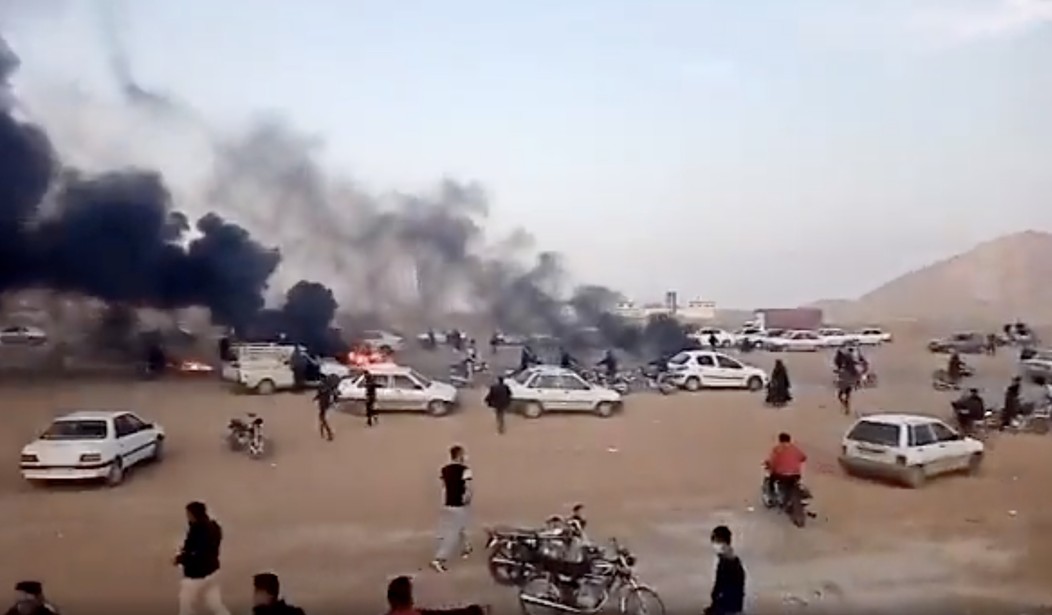In what some observers are calling the most violent crackdown by Iranian security forces since last July’s protests against the regime’s handling of a water crisis in the drought-stricken southwestern province of Khuzestan, Iranian protesters were set upon by police armed with tear gas, batons, and pellet weapons near the town of Isfahan. Some reports included shots being fired by the police at protesters.
۵ آذر ۱۴۰۰ #اصفهان
منبع: maleki pic.twitter.com/mbPi6Pt73L— Arash Sadeghi (@Arash_sadeghii) November 26, 2021
Once again, the lack of water was the issue as hundreds of farmers staged a sit-down strike to protest government water policies. They had gathered along the banks of the bone-dry Zayanderud River, constructing a kind of tent city. But videos of the engagement with Iranian police show the tents ablaze and the encampment in shambles.
شعار مرگ بردیکتاتور
#اصفهان
جمعه ۵ آذر ۱۴۰۰ pic.twitter.com/QvKr1MJjOu— بگونه (@begoonah1) November 26, 2021
After the July crackdown, London-based rights group Amnesty International said it had determined that Iranian security forces killed at least eight protesters and bystanders in seven cities, based on video footage and “consistent accounts” from Iran-based sources. Iranian state media reported the killings of at least four people in the Khuzestan protests, including a police officer, and blamed the deaths on saboteurs.
In Friday’s Isfahan protest, the Iran Human Rights group said in a statement that Iranian security forces used batons, tear gas, pellets and live ammunition against demonstrators. It expressed “grave concern” about the situation and urged the international community to “immediately respond to stop the state repression and killing of defenseless civilians.”
One report said that 50 protesters were injured after a “massive mobilization” of security forces.
Just in: At least 50 protesters in #Isfahan injured. Despite massive mobilisation of repressive forces, using tear gas, and the onslaught by motorcycle and special units, defiant youth and farmers of Isfahan continued their uprising. #Iran #IranProtests pic.twitter.com/bCabm6h39B
— Hossein Abedini (@HoAbedini) November 26, 2021
Authorities, when faced with mass protests and demonstrations, are getting more and more sophisticated about limiting or cutting off internet access.
The Iranian goons are among the best at it.
Some people in Isfahan later Friday reported that mobile internet service was disrupted in the city. The group NetBlocks reported an outage in recent days that also affected the southwestern city of Ahvaz amid water protests there.
Iran in the past has shut down both mobile and landline internet to halt protests. That included a nationwide shutdown during 2019 protests over rising government-set gasoline prices that Amnesty International says saw over 300 people killed.
⚠️ Confirmed: Network data indicate a fall in internet connectivity in parts of #Iran from the morning of Thursday 25 November.
The ongoing outage has subnational impact and may be connected to protests against the government’s water management policies #Ahvaz 📉 pic.twitter.com/2szRwQawfx
— NetBlocks (@netblocks) November 26, 2021
None of this threatens the regime’s hold on power, of course. But in the last 10 years, we’ve seen several Middle Eastern regimes fall after popular protests. The government that replaced them was never any better, but it shows how even an entrenched authority can be undone by popular protests.










Join the conversation as a VIP Member